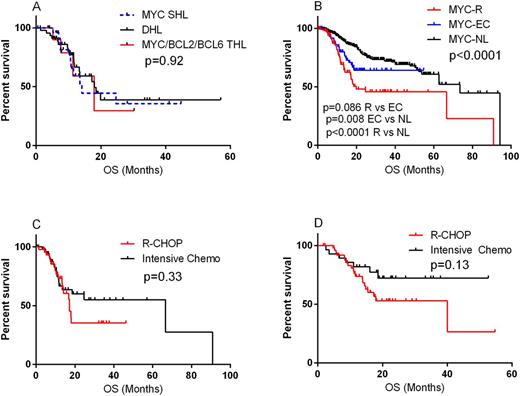Abstract
Introduction: It is known that patients with double hit (DHL) and triple hit lymphoma (THL) have a significantly worse prognosis compared to patients with diffuse large B-cell lymphoma (DLBCL) without MYC rearrangement (MYC-R). Some studies have shown that DLBCL patients with MYC rearrangement only (single hit lymphoma; SHL) also have a poor prognosis similar to those with DHL/THL. However, it is not uncommon for fluorescence in situ hybridization (FISH) to detect extra copies (EC) of MYC, BCL2 or BCL6 in the absence of rearrangement. The potential role of these extra copies (EC) on survival has not been fully explored. In the current study, we focused on the prognostic significance of MYC-EC in comparison with MYC-R in patients with de novo DLBCL treated with rituximab-chemotherapy.
Materials and Methods: A total of 664 de novo DLBCL cases with MYC/8q24, BCL2/18q21 and BCL6/3q27status confirmed by FISH and/or karyotype from 2010-2015 were included. MYC SHL, DHL and THL were identified if they had rearrangements of MYC only, both MYC and BCL2 or BCL6, or concurrent MYC, BCL2, and BCL6, respectively. Positive expression for MYC or BCL2 by immunohistochemistry was defined by >40% and >50% staining in the lymphoma cells, respectively.Patient survival was analyzed using the Kaplan-Meier method and compared using the log-rank test.Fisher's exact test was used to compare the clinicopathologic features.Statistical analysis was performed using SPSS 23 software.
Results: 105 DLBCL had MYC-R, 77 had MYC-EC, and 482 had no MYC abnormality (MYC-NL). The 105 MYC-R cases included 28 SHL, 45 DHL (39 MYC/BCL2 and 6 MYC/BCL6 DHL), 11 THL, and 21 with unknown BCL2 or BCL6 status. Overall, the clinicopathologic features including overall survival (OS) were similar among SHL, DHL, and THL patients (Figure 1A, p=0.92). Patients with DLBCL harboring MYC-R had more aggressive clinicopathologic features than those with MYC-EC or MYC-NL (p<0.05). There was no difference in the overall survival (OS) between patients with MYC amplification (≥5 copies) compared to those with 3-4 copies of MYC (p=0.41); as such; they were combined into to one group (designated MYC-EC) for further analysis. The features of patients with MYC-EC were largely similar to those with MYC-NL except a lower CR rate in MYC-EC group (57% vs 72% in MYC-NL, p=0.011).
Although both the MYC-R and MYC-EC groups demonstrated a worse OS than MYC-NL patients (p<0.01), the MYC-EC group had a trend towards a better OS when compared with the MYC-R group (p=0.086, Figure 1B). As expected, more patients received intensive induction chemotherapy (R-EPOCH & R-Hyper-CVAD) in the MYC-R group than in the MYC-EC or MYC-NL group (p<0.01). Compared with R-CHOP, intensive induction chemotherapy showed only a trend towards better OS in the MYC-R and MYC-EC group (Figure 1C & 1D respectively).
By multivariate analysis, MYC-R (HR=2.55, p=0.0001) but not MYC-EC was an independent prognostic factor in de novo DLBCL patients.
Conclusion: Patients with DLBCL harboring extra copies of MYC have clinicopathologic features more in common to DLBCL patients with normal MYC status than those with MYC rearrangement. The OS in patients with DLBCL harboring extra copies of MYC was significantly worse than in DLBCL patients without MYC abnormality; however, it was not as poor as that seen in patients with DLBCL with MYC-R. Compared to R-CHOP, intensive induction regimens (R-EPOCH & R-Hyper-CVAD) showed only a trend towards better prognosis in DLBCL patients with MYC rearrangement or extra copies.
Westin:Chugai: Membership on an entity's Board of Directors or advisory committees; Spectrum: Membership on an entity's Board of Directors or advisory committees; Celgene: Membership on an entity's Board of Directors or advisory committees; ProNAi: Membership on an entity's Board of Directors or advisory committees. Reddy:GILEAD: Membership on an entity's Board of Directors or advisory committees; celgene: Membership on an entity's Board of Directors or advisory committees; INFINITY: Membership on an entity's Board of Directors or advisory committees; KITE: Membership on an entity's Board of Directors or advisory committees.
Author notes
Asterisk with author names denotes non-ASH members.


This feature is available to Subscribers Only
Sign In or Create an Account Close Modal